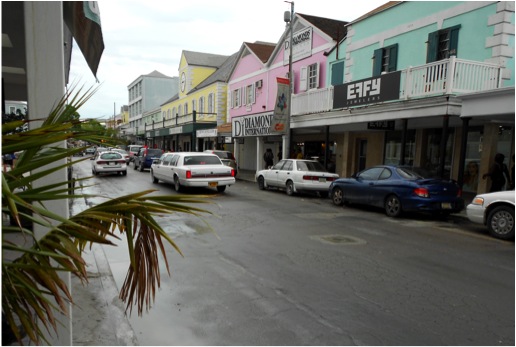Above: downtown Nassau (Photo: CJ)
By Alexander Britell
On Monday, ratings firm Standard & Poor’s announced it had lowered the Bahamas’ sovereign credit rating from BBB+/A-2 to BBB/A-3, citing a heavier weight its new sovereign credit rating criteria places on economic factors, along with what it called a dependence on tourism and the US market. In order to learn more, Caribbean Journal talked to Dr Lisa Schineller, Director in Standard & Poor’s Soverign Ratings division.
The analysis mentions the Bahamas’ dependence on tourism and the US. Can you expand on that?
Looking at the structure of the Bahamian economy, more or less 50 percent of GDP is related to tourism, and 50 percent of the labour force is related to tourism; that is a significant concentration of the economy in one sector. In addition to that, most of the tourists – around 80% — are from the US as opposed to being drawn from a more diversified set of countries. Hence, the economy is extremely dependent on the US, so there are concentrations several fold, so to speak. And that element weighs more heavily in our revised sovereign methodology.
What other sectors factored in?
The financial sector is the next-largest sector in The Bahamas, accounting for close to 15 percent of GDP. According to our new criteria we consider concentration to be high when a sector accounts for more than 20 percent of the economy — in the case of The Bahamas, that’s a concentration in tourism.
How much of this rating change is due to the new weighting criteria, and how much is independent of it?
To put this rating action in perspective, we downgraded the sovereign rating on The Bahamas at the end of 2009, reflecting, on balance, a deterioration in its fiscal profile. Net general government debt used to be below 20 percent of GDP, and rose to the mid-30s in 2010; we still expect debt/GDP to rise, though at a much more reduced pace, over the forecast horizon to a bit over 40 percent several years out. This weakened fiscal position was certainly a key component for the previous downgrade. However, lackluster growth did also contribute as well via weaker fiscal dynamics. The current downgrade stems from the new methodology. A credit weakness that we had already highlighted for The Bahamas – namely the important dependence on tourism and the US economy coupled with the fact that over the past decade there has been little to no growth in per-capita GDP – carries a greater weight in the updated sovereign analysis. This downgrade reflects the heavier weight assigned to this already-articulated credit weakness.
The analysis mentions the strong track record of Bahamian political and macroeconomics policy — has that changed — or is that important to the rating?
That is a very important element of the analysis. Under the new criteria, the combination of the political and economic scores carry a heavier weight. The political strengths of The Bahamas are important elements that support the rating, and clearly, despite what I have just said, in terms of the tourism concentration and sluggish growth, The Bahamas’ economic history has delivered high levels of per-capita GDP for the economy. There is certainly, in our view, political stability and policies in place that have generated this type of prosperity in the economy. With that said, the concentration is a vulnerability that we have always highlighted. It comes out more strongly with the changes in the methodology, as it may for other Caribbean countries.







